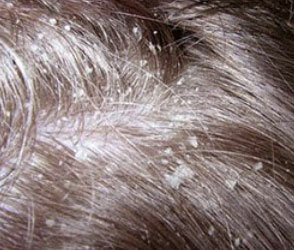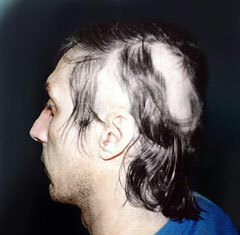The problem of baldness in the male half of the population is fairly common. Usually alopecia in men is caused by a genetic predisposition and starts actively progressing after 40-45 years, but have also been described cases earlier baldness, that is abnormal hair loss and death of hair follicles can be diagnosed only after 20 years.
There is another very significant factor causing alopecia in men aged 20 to 50 years. He also, like genetic predisposition, has no pathological motive, but acts as a cause of hair loss in 90-94% of cases. We are talking about the features of hormonal levels in the stronger sex, that is, about the impact of a certain hormone in the vital activity of the hair bulb.

Hair loss in men, characterized by the presence of the gene and hereditary feature of the endocrine system is considered quite normal physiological phenomenon. Any specific treatment forms of alopecia does not require, but in today's world there are technology inhibits the process of hair loss and allowing to keep the scalp as possible longer.
Definition, forms and types of pathology
In order to be aware and to recognize the first signs of alopecia, it is necessary to understand what it is and why this pathology can develop in humans. It should be noted that the disease affects women and children. Not as often as representatives of the male, but still at risk is all the world's population.The concept of alopecia include the complete or partial loss of hair, which is accompanied by a lack of new growth. Except androgenic form of the disease, there are still a few, due to pathological etiology, that is, alopecia reason in some cases may be hiding in the large-scale defeat of the body where hair loss appears as investigation. Distinguish the following symptoms of hair loss, which an experienced doctor can identify and diagnose alopecia certain kind, namely:
- alopecia (nesting) represented by small foci (up to 1-2 cm. in diameter) fell in the middle and on the edge of the damaged hair bald head, which often merge with each other to form a large area of destruction;
- scar characterizes hair bulb replacement of lost connective tissue (scar);
- subtotal is characterized by loss of not more than 40% of the hair on the head;
- total form causes a complete loss of hair covering the head;
- universal form characterizes the loss of hair on the body, that is, except for the head and upper involved lower extremities, eyebrows, eyelashes, and beard, that the photo alopecia may be considered in men at different interpretations.
Types of hair loss in most cases moving from one form to another, which is observed with the progression of the pathology.
The disease is considered to be treacherous and unpredictable, because it is impossible to predict the specifics of the course and outcome of alopecia even when adequately prescribed treatment. Recurrences in the background of well-being after the application of therapeutic measures and self-healing without any medical intervention with the presence of provoking a common disease, it is inherent to alopecia. Some scientists believe this fact is another confirmation of the self-sufficiency of the human body.Causes of alopecia
In addition to hereditary factors and genetic predisposition, male alopecia can occur for other reasons. Thus, approximately 5-6% of cases of alopecia, experts attributed to the following factors etiotropic:- lack of some specific vitamins and minerals;
- fungal infections of the skin;
- infectious diseases;
- reduced immune defense;
- diseases of the digestive organs;
- endocrinological diseases;
- hormonal failures due to thyroid gland disease;
- worm infestation;
- severe head injuries;
- close and permanent contact with chemicals, radioactive substances;
- poisoning by heavy metal salts;
- severe stress or permanent state of mental and emotional surge;
- use of certain drugs;
- Autoimmune processes are very often the cause of alopecia, that is, the body's immune cells perceive the hair follicle and its waste products of the foreign agent, which begin actively fight.

The symptoms of alopecia in men
Empowered loss and thinning hair is seen as the main symptom is the appearance of alopecia in men. Complaints and observations of the patient is usually as follows:- hair color becomes more dull, getting burnt shade;
- the texture of the hair becomes thinner, resembling fluff;
- growth rate is significantly reduced;
- there are a receding hairline.
Features of diagnostic measures
Already at the first examination of the patient may suggest triholog visual appearance of alopecia and neglect step process. Next, the doctor clarifies in detail the following aspects of life, seek the advice of a man:- the presence of the family of such phenomena have blood relatives;
- Lifestyle;
- the specifics of the work;
- eating habits;
- social status;
- presence of chronic pathologies.
Only a comprehensive survey will provide full information on the reasons which provoked alopecia, and increase the chance of a successful solution to the problem. Having a perfect information, the doctor will be able to approach the problem precisely.
Management of patients with androgenetic alopecia
In most cases, the treatment of alopecia in males androgen etiology is not carried out, because there is no pathological motive in this process. While some men, wishing to preserve the lush head of hair, at the first signs of alopecia refer to specialists. In today's world, there are special techniques that allow slow the spread of the process of hair loss. At the core of such methods is the impact on the level of DHT and hair follicles. We are talking about reducing the amount of hormones and stimulate the vital functions of the roots of hair on his head. These manipulations are suitable in the initial stages of development of androgenic alopecia, or for the prevention of alopecia in men.Doctors distinguish the following stages of development of physiological alopecia:
- in the beginning there are small, barely noticeable receding hairline in the frontal part that defines the first stage of the process;
- the second stage is characterized by the proliferation of alopecia process closer to the crown of the head;
- area of the temporal and frontal part have little or no vegetation on the top of the hair thinned considerably;
- fourth stage leads to the existence of several areas of baldness, that is on both sides of the forehead and crown;
- alopecia boundary between portions merge to form baldness in a horseshoe shape, which is characteristic for the fifth stage;
- widespread bald area in the frontal, temporal, parietal and occipital small portion of the head 6 defines a step.
It should be noted that many doctors do not recommend to get involved in this process, so as not to provoke a hormonal failure, which can lead to more serious problems.
Treatment of alopecia pathological etiology
It does not exist for the treatment of alopecia in men some specific methods. The doctor determines the therapeutic plan activities based on anamnesis data collection, laboratory studies related diseases, which in most cases are the cause of alopecia. The following methods are commonly used:- treatment of the underlying disease;
- Immune reconstitution reserves;
- hormone replacement therapy;
- replenishment of vitamins, minerals, essential amino acids and proteins;
- the use of physical therapy;
- Local effects on the hair follicle.
Found a bug? Select it and press Ctrl + Enter



